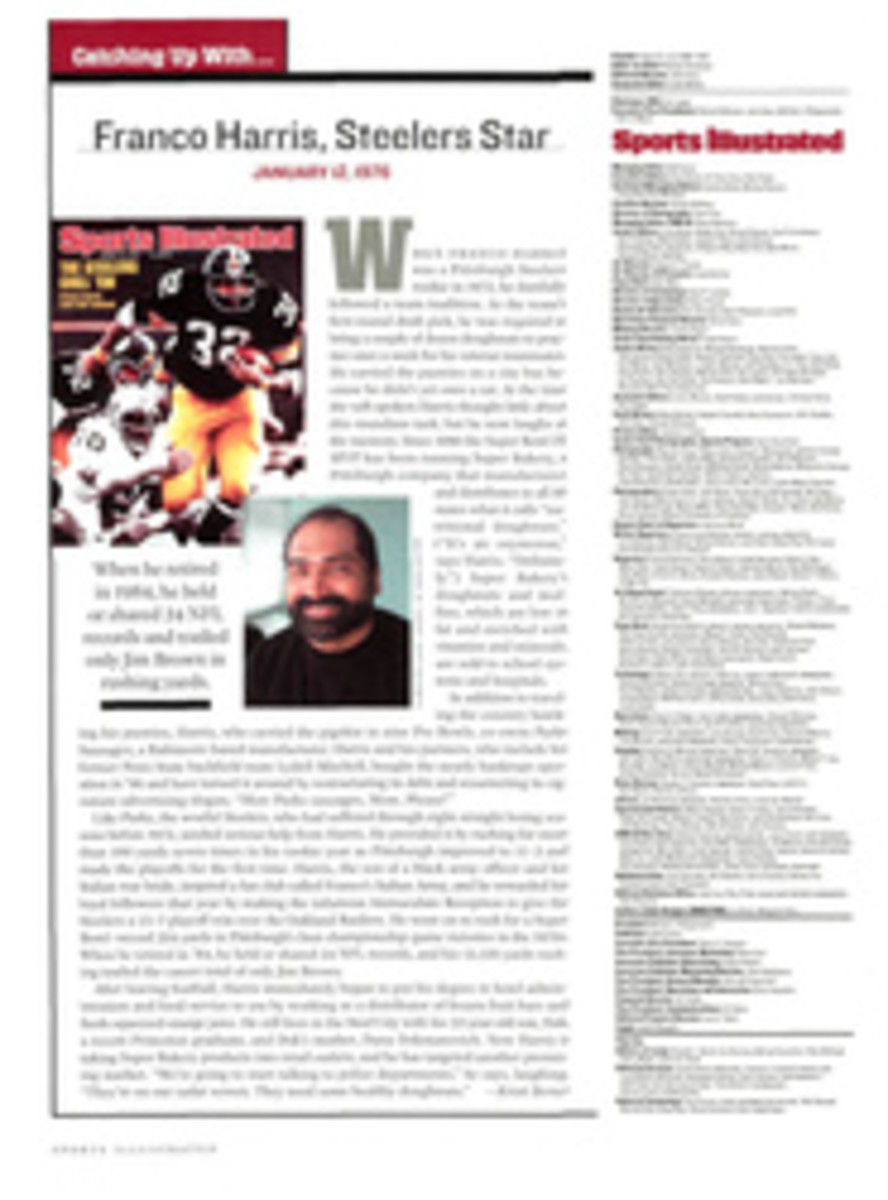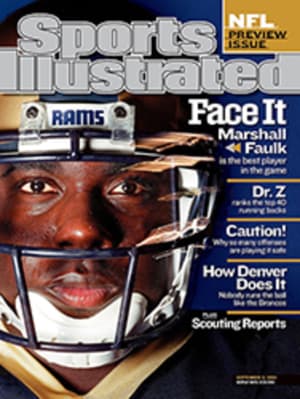
Strong Finishing Kick A hard-fought victory by the CyberRays capped a fitful first season for the WUSA
The Bay Area CyberRays were celebrating last Saturday, jumping
rhythmically on the victory stand at Foxboro Stadium in the
manner of champion soccer teams around the world, when defender
Brandi Chastain pulled teammate Tisha Venturini close and defined
the moment. Their team had just won the first Women's United
Soccer Association championship on penalty kicks after a 3-3
thriller against the Atlanta Beat, and as fireworks boomed above
the crowd of 21,078, Chastain screamed, "You know what? This is
the most special moment on a soccer field that we've ever had!"
Really? Even better than the one on July 10, 1999, when
Chastain's World Cup-winning, jersey-shedding, Title IX-
affirming penalty kick that brought the women's game into the
mainstream? Yeah, really. "The World Cup happens every four
years," Chastain explained later, while admiring the newly
forged Founders Cup trophy. "This league will be going every
summer, and there will be a champion every year. To me, it is so
important for young girls to be able to come to the stadiums on
a regular basis, not just every four years."
This time, however, Chastain didn't have to take her team's final
penalty kick to clinch the win--"Thank God," she said--an honor
that went instead to Bay Area's fourth-round kicker, Julie
Murray, the Australian striker who was named the Founders Cup
MVP. In scoring nine goals during the regular season, Murray
helped prove that it's one thing for the WUSA to sign the best
women's soccer players in the world and another to get them
playing with precision on the same team. Mia Hamm's Washington
Freedom, for example, finished tied for last at 6-12-3, in part
because the team's Brazilian forwards, Pretinha and Roseli, were
spectacular busts, unable to develop any chemistry with their
American teammates.
The CyberRays were different. "Before I got here, besides Brandi
and Tisha and [goalkeeper] LaKeysia Beene, I didn't know any of
the American players," Murray said last week, "but I thought the
best teams would be the ones that integrated their international
and American and college players the best." After a 1-4-1 start
Bay Area coach Ian Sawyers added a third forward (Fresno State
alumna Christina Bell) and moved Chastain from midfielder back to
defender. Suddenly the CyberRays' cosmopolitan lineup, which
included Murray and Dianne Alagich from Australia and Katia and
Sissi from Brazil, began to cohere, and the San Jose-based squad
lost only twice in its last 17 matches.
No play in the title game better demonstrated Bay Area's tight
teamwork than Bell's perfect 30-yard through-ball to a streaking
Murray, who coolly dribbled around Beat goalkeeper Briana Scurry
and tied the score at two near the end of a wild first half.
"Belly knew I was going to be there, and vice versa," Murray
said. "She knows what I can do and what I can't, and that comes
from time spent on the field together."
For the league at large, there were other insights to be gained
in Year One, to wit:
The WUSA struggled to establish itself nationally. Though it
exceeded its modest attendance goal of 7,500 per game, averaging
8,133 in its eight cities, the WUSA attracted only three national
sponsorships--half its targeted number--and averaged a puny 0.4
Nielsen rating for its broadcasts on TNT and CNN/SI. "We did a
pretty good job of branding teams in their markets, but we didn't
do that across the country," WUSA chief operating officer Tony
DiCicco said last Saturday. "We had quite a few potential
sponsors at this game, and we hope to capitalize on that."
Hamm got it done at the turnstiles but not on the field. Though
Hamm was clearly the WUSA's attendance savior--the Freedom drew an
average of 12,748 fans at home and away, 57% more than the
league-wide mark--she scored only six goals in 19 games (10th in
the league) for the dismal Freedom, despite taking more shots
than all but four players. "Mia needs to be told, 'Your job is to
score goals,'" says DiCicco, her former U.S. coach, noting that
Hamm played out of position as a midfielder for the first half of
the season. "From a league standpoint we also could have done a
better job of deflecting all the attention she got. Next year
you'll see renewed energy from her."
Which means that the world's best player is...New York Power
forward Tiffeny Milbrett, whose 16 goals led the WUSA and earned
her the league MVP award. In fact, if world governing body FIFA
were to adopt the idea of naming a World Player of the Year for
women as it does for men, the last four awards would have gone to
Hamm (1998), China's Sun Wen ('99) and Milbrett (2000 and '01).
The mystery is why the electrifying and personable Milbrett has
yet to enjoy the mass appeal of Hamm or, for that matter, U.S.
teammates Chastain and Julie Foudy. Give her time, though: She's
only 27 and will be in her prime when the 2003 World Cup rolls
around.
The level of play improved as the season progressed. Despite a
shaky first month in which teams struggled to score--and often to
string together more than three passes in a row--the two semifinal
playoffs and the title game were all dynamite theater, featuring
chest-clutching finishes and 5.3 goals per match. It's also worth
noting that the U.S. national team roster for next week's U.S.
Cup includes nine players whose call-ups were solely the result
of their performance in the WUSA.
Stars from unlikely countries had a big impact. Some of the
league's most skillful attackers came from nations that are
barely blips on the international women's soccer scene. Four of
those players--Murray, Kelly Smith (England) of the Philadelphia
Charge, and Atlanta's Charmaine Hooper (Canada) and Homare Sawa
(Japan)--provided the punch that sent their teams to the
playoffs. "Sawa and I went low [fifth out of eight teams] in the
foreign draft because we weren't seen as high-profile enough,"
says Hooper, whose 12 goals were second in the WUSA. "I'm sure
people were thinking, Canada and Japan aren't powerhouses. Who
do they produce? Nobody. They thought a Canadian wasn't going to
draw people to the stadium, but you know what? A winning team
brings people to the stadium."
League investors are willing to dig deeper into their pockets.
Initially the WUSA's investors, the owners of five cable
companies headed by Discovery CEO John Hendricks, committed to
spending $40 million over five years, but last spring they upped
their investment to $64 million over five years. However, with
only three sponsorships and $4 million to $5 million more in
operational costs than expected this season, Hendricks says that
when investors meet later this month they will consider raising
their ante to $95 million. "We're committed to this league's
breaking even," he adds, "whether it's three, four or five years
down the road."
Building a league on the fly has its pitfalls--and surprising
successes. Woefully disorganized at first, the WUSA didn't
announce team names, schedules and rosters until the final
fevered six months before play began in April, gaffes that surely
hindered growth in Year One.
Some misstarts had happy endings, though. Consider the case of
the CyberRays and Sawyers, an irascible Englishman who for years
was known mostly as Mr. Julie Foudy. After coaching Stanford's
women's team to a 50-8-4 record from 1993 through '95, Sawyers
resigned and embarked on an unsuccessful attempt to qualify for
the PGA Tour. He was "busy missing cuts on the mini-tour" last
December, he says, when Notre Dame coach Randy Waldrum backed out
of the CyberRays' job two days before the draft. Sawyers served
as an emergency fill-in, was offered the job permanently later
that month and last week was named WUSA Coach of the Year. You
can now call him Mr. Ian Sawyers, thank you.
"Believe me," Chastain says, "Ian has his own personality, and
it's very strong." No kidding. During Bay Area's semifinal
playoff win over the Power, Sawyers was ejected when he dropped
an F bomb on the referee--on national television, no less.
Yet if Sawyers's mouth sometimes fails him, his eye does not. It
was Sawyers who drafted Murray after she had been passed over as
one of the 16 international players signed by the league and
dispersed among the eight teams. (Murray was ready to return to
her sports marketing job in Sydney had she gone unpicked.) And it
was Sawyers who was coaching the semipro Sacramento Storm in 1995
when he helped resurrect the career of a 27-year-old
national-team reject named Brandi Chastain.
The rest is history, to which the remarkable Chastain added
another chapter on Saturday. She scored the first goal and raised
another shiny trophy, and the marketing folks got to go home
happy too. After all, what are the first six letters of branding
but B-R-A-N-D-I?
COLOR PHOTO: PHOTOGRAPHS BY GEORGE TIEDEMANN The winning boot came from Murray (8), an Aussie and the FoundersCup MVP.
COLOR PHOTO: PHOTOGRAPHS BY GEORGE TIEDEMANN Beene couldn't prevent Hooper (10) from scoring and putting the Beat in front 2-1.

